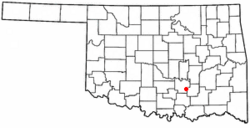Stonewall, Oklahoma facts for kids
Quick facts for kids
Stonewall, Oklahoma
|
|
|---|---|

Location of Stonewall, Oklahoma
|
|
| Country | United States |
| State | Oklahoma |
| County | Pontotoc |
| Area | |
| • Total | 0.47 sq mi (1.23 km2) |
| • Land | 0.47 sq mi (1.23 km2) |
| • Water | 0.00 sq mi (0.00 km2) |
| Elevation | 702 ft (214 m) |
| Population
(2020)
|
|
| • Total | 414 |
| • Density | 871.58/sq mi (336.29/km2) |
| Time zone | UTC-6 (Central (CST)) |
| • Summer (DST) | UTC-5 (CDT) |
| ZIP code |
74871
|
| Area code(s) | 580 |
| FIPS code | 40-70500 |
| GNIS feature ID | 2413338 |
Stonewall is a small town located in Pontotoc County, Oklahoma, in the United States. It was named after a famous general, Stonewall Jackson. The town's post office first opened in December 1874.
Contents
A Look at Stonewall's History
Before Stonewall became a town, the land belonged mostly to the Chickasaw tribes. The first person to settle here was Robert L. Cochran from Georgia. He started a trading post where Stonewall is now. This area was first called Pontotoc, which later became the name of the county. A post office also opened there in 1858. The settlement was then named Stonewall to honor a general from the Civil War, Stonewall Jackson. By the late 1800s, Stonewall grew bigger. It had many businesses like a cotton gin, stores, a hotel, and a place for stagecoaches.
Moving the Town
In the early 1900s, Stonewall was growing even more. A new railroad line from Oklahoma City was built, passing through a nearby town called Ada. People debated if they should move Stonewall closer to the railroad. Many did not want to leave because Stonewall was important as the main town of Pontotoc County in the Indian Territory. Eventually, some people did move. The old site was renamed Frisco. The new Stonewall site became official. With businesses and the post office moving, the town's population grew.
The 1930s and Beyond
In 1930, the Great Depression did not affect Stonewall much. This was because of oil discoveries in the town. However, the oil boom also caused environmental problems. The local creek became polluted with waste. People had to dig wells to get clean water. In 1932, a famous outlaw named Charles "Pretty Boy" Floyd and his friend George Birdwell robbed the Stonewall Bank. They took $600 and escaped.
Today, Stonewall is a smaller town. Highway 3 was rerouted away from the town, which caused businesses to slow down. There are still some businesses in Stonewall. However, many people who live there work in the nearby city of Ada.
Where is Stonewall?
Stonewall is a small town. According to the United States Census Bureau, the town covers about 0.3 square miles (0.78 square kilometers) of land. There is no water area within the town limits.
People of Stonewall
| Historical population | |||
|---|---|---|---|
| Census | Pop. | %± | |
| 1910 | 494 | — | |
| 1920 | 622 | 25.9% | |
| 1930 | 478 | −23.2% | |
| 1940 | 761 | 59.2% | |
| 1950 | 634 | −16.7% | |
| 1960 | 584 | −7.9% | |
| 1970 | 653 | 11.8% | |
| 1980 | 672 | 2.9% | |
| 1990 | 519 | −22.8% | |
| 2000 | 465 | −10.4% | |
| 2010 | 470 | 1.1% | |
| 2020 | 414 | −11.9% | |
| U.S. Decennial Census | |||
In 2010, there were 470 people living in Stonewall. These people lived in 186 households. About 106 of these were families. The town had 238 housing units.
Most people in Stonewall are White. Some are African American or Native American. A small number of people are from other races or a mix of races. About 3% of the population is Hispanic or Latino.
About 19.6% of households had children under 18 living with them. The average household had 2.32 people. The average family had 3.06 people. The population was spread out by age. About 26.5% were under 18. About 20.5% were 65 or older. The average age in town was 42 years old.
Education in Stonewall
Students in Stonewall attend schools in the Stonewall Public Schools district.
Stonewall High School is known for its Longhorn athletics. The boys' baseball team has won two state championships. They won their first in the spring of 1979. Their second championship was in the fall of 2000.
See also
 In Spanish: Stonewall (Oklahoma) para niños
In Spanish: Stonewall (Oklahoma) para niños

